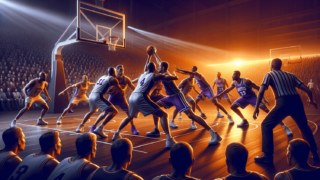
Understanding the Basketball Backcourt Violation Rule
Written by: Basketball Universe
Last updated:

When it comes to grasping the fundamentals of basketball, there’s no shortage of nuance and excitement behind every rule in the book. Welcome to the world of the basketball backcourt violation rule! Whether you’re a newcomer or a seasoned fan, understanding this oft-overlooked yet critical aspect of the game can turn you into a bona fide hoop-enthusiast. In this fun, informative, and professionally articulated blog post, we’ll unpack every detail of the backcourt violation rule, dive into its real-world implications, and break it all down with the panache that only a true basketball enthusiast can appreciate!
Understanding the Basketball Backcourt Violation Rule
The basketball backcourt violation rule comes into play when an offensive team crosses from the backcourt (the half of the court with their own basket) to the frontcourt (the half with the opponent’s basket) and then, without the defense touching the ball, returns the ball to the backcourt. This action results in a turnover, with the opposing team gaining possession of the ball. The primary purpose of this rule is to maintain the flow and pace of the game while preventing teams from stalling or running out the clock.
The Ins and Outs of the Backcourt Violation Rule
Before we take a deep dive into the world of backcourt violations, it’s vital to have a solid foundation in basketball rules and terminology. The basketball court comprises two halves: the backcourt, which is the half where a team’s own basket is located, and the frontcourt, where the opposing team’s basket is located. The violation occurs when the offensive team crosses into the frontcourt and then returns the ball to the backcourt without the defense touching it.
The 8-Second Rule
One crucial aspect of understanding the backcourt violation rule involves the 8-second rule. This rule states that, in the NBA, an offensive team has 8 seconds to move the ball beyond the half-court line, effectively advancing it to the frontcourt. In college and FIBA games, the offensive team has 10 seconds. If the team fails to do so, it loses possession, and the opposing team takes over the ball. This rule aims to ensure that the game maintains a high-energy pace and avoids stalling.
Instances that Trigger a Basketball Backcourt Violation
Now that we have a firm grasp on the fundamental aspects of the backcourt violation rule, let’s dive into the specific situations that trigger a violation. Here are the most common scenarios:
Scenario 1: Over-and-Back
The classic instance of a backcourt violation is referred to as the “over-and-back.” This occurs when the offensive team moves the ball into the frontcourt, and the last player to touch the ball before it crosses the halfway line does so with both feet firmly in the frontcourt. Then, without any defensive player touching the ball, it is returned to the backcourt. The moment the offensive team touches the ball in the backcourt after this sequence, a violation is called, and the opposing team gains possession.
Scenario 2: Inbound Pass Gone Awry
Another common scenario occurs during inbound passes. If a player inbounds the ball from the sideline or baseline while standing in the frontcourt and the receiver moves the ball back into the backcourt without any defensive player touching it, a backcourt violation is called. Keep in mind that for this to happen, the player receiving the pass must establish frontcourt status by having both feet in the frontcourt when first touching the ball.
Scenario 3: Jump Ball Implications
Jump balls present unique and fascinating applications of the backcourt violation rule. In the case of a jump ball, it is crucial to understand which team has established team frontcourt status. Once a team gains possession of the ball by controlling the jump ball and a player touches the ball with both feet in the frontcourt, that team has established team frontcourt status. If the ball goes back to the backcourt without defensive intervention, a violation is called.
Key Exceptions to the Backcourt Violation Rule
As with most basketball rules, there are exceptions to the backcourt violation rule. These scenarios are important to know as they add depth and nuance to the game. Here are a few critical exceptions:
Exception 1: Loose Ball Recovery
In the event of a loose ball situation, such as a blocked shot, bad pass, or ball that slips from a player’s grasp, the backcourt violation rule does not necessarily apply. If a team is considered to have lost possession (i.e., does not have control of the ball) and an offensive player then subsequently touches the ball in the backcourt, a backcourt violation is not called.
Exception 2: Defense-to-Offense Transition
When the defensive team successfully steals the ball or gains possession through rebounding or forcing a turnover and passes it into their own backcourt to start a fast break, this does not constitute a backcourt violation. The defensive team is allowed to pass the ball to the backcourt after gaining possession, as they have not yet established team frontcourt status.
Exception 3: Ball Touched by the Opponent
If a defensive player touches the ball and causes it to return to the offensive team’s backcourt, there is no backcourt violation. Even if the offensive player subsequently touches the ball in the backcourt after defensive interference, they have not committed a violation, as the defensive touch nullified the original offensive frontcourt status.
Backcourt Violations in Different Leagues
While the basic concept of the backcourt violation rule remains consistent across various leagues, understanding differences in both language and application are essential for a well-rounded grasp of the game. Let’s delve into how the rule is applied across several leagues.
The NBA
In the NBA, one key difference from other leagues is the 8-second rule; the offensive team has only 8 seconds to move the ball past the half-court line. Another distinction is that, in the NBA, once an offensive player’s foot is lifted from the backcourt during the process of dribbling or receiving the pass, that player cannot return to the backcourt.
College Basketball (NCAA)
In college basketball, the primary difference from the NBA is the 10-second rule; the offensive team has 10 seconds to advance the ball to the frontcourt. Apart from this variation, the rules governing backcourt violations align closely with those of the NBA.
International Play (FIBA)
In FIBA basketball, the backcourt violation rule is virtually identical to NCAA basketball: a 10-second rule is employed, and most other aspects of the rule parallel those of the NBA and NCAA.
Mastering the Art of Avoiding Backcourt Violations
Now that you have a comprehensive understanding of the basketball backcourt violation rule, let’s discuss some strategies and tips for avoiding these costly turnovers:
Tip 1: Court Awareness
Developing a keen sense of court awareness is essential in avoiding backcourt violations. Knowing where you and your teammates are positioned in relation to the half-court line will help prevent errant passes and accidental crossing.
Tip 2: Communication
Effective communication with teammates is crucial in avoiding backcourt violations. Alerting teammates to their position on the court and the presence of defenders will reduce the chances of an ill-advised cross-court pass.
Tip 3: Utilizing the Dribble
Dribbling the ball in a controlled manner can help players evade backcourt violations. By maintaining a cautious dribble, players can assess the court and make well-informed decisions that keep their team out of backcourt trouble.
Tip 4: Proper Inbounding
Paying keen attention to inbounding the ball is imperative in avoiding costly turnovers. Ensure that the inbound pass is directed towards the frontcourt and clear of any potential defensive interference.
With this newfound knowledge and these helpful tips, you’ll be well on your way to mastering the nuances of the basketball backcourt violation rule! The level of detail covered should empower you to be an informed and insightful fan, participant, or coach of the game you love.
Historical Evolution of the Backcourt Violation Rule
Understanding the history and development of the basketball backcourt violation rule adds depth to the appreciation for the game. In the early years, basketball didn’t have a clearly defined backcourt violation rule, which led to slow-paced games and defensive struggles. As the game evolved, rules were established to encourage a faster, more dynamic style of play, fundamentally shaping the way the game is now enjoyed by millions worldwide.
The Introduction of the 10-Second Rule
Introduced in the 1930s in college basketball, the 10-second rule aimed to speed up the game by requiring the offensive team to advance the ball to the frontcourt within ten seconds. As this sped up the pace and forced players to think and act faster, basketball became inherently more captivating and engaging for the audience.
The NBA’s Adoption of the Rule
When the NBA was established in 1946, it adopted many of the rules already in place in college basketball, including the 10-second rule. However, in the 1990s, the NBA witnessed a slower, grind-oriented style of play, often stalling both the progress and the excitement of the game. As a consequence, the league decided to implement the 8-second rule in 2001. By reducing the time for the offensive team to advance the ball, the NBA sought to speed up gameplay, adding drama and adrenaline to the game while making it more visually appealing.
How Backcourt Violations Impact Game Strategy
The backcourt violation rule directly influences the tactics employed by both the offensive and defensive teams. These strategies can be a critical part of winning or losing a basketball game. To understand this strategy and how it affects gameplay, let’s take a closer look.
Press Defense: Putting the Heat on the Offense
The press defense strategy relies on applying pressure to offensive players, making it difficult for the offensive team to move the ball past the half-court line. By forcing the offense to commit turnovers or provoke backcourt violations, the defense can regain possession and convert those into fast-break opportunities, eventually seizing control of the game. Press defense can come in various forms, such as full-court press, half-court press, or even a subtle trap, but the underlying objective remains the same: cause turnovers and generate opportunities for points.
Offensive Strategies against Press Defense
Offensive teams are well aware of the tactics used by press defenses, and in turn, adapt their gameplay to avoid turnovers and backcourt violations. A few common techniques employed to mitigate press defense include setting screens, using crisp passes, and maintaining an organized offensive set. These efforts combine to create open lanes for teammates and empower the offensive players to advance the ball efficiently and safely towards the frontcourt, all the while adhering to the backcourt violation rule.
Additional Resources for Learning About Basketball Rules
Interested in sharpening your knowledge of basketball rules and the backcourt violation rule? Here are some trusted resources to elevate your understanding of the game:
- NBA Official Rules: Visit the NBA’s official website to explore a comprehensive guide to league rules and regulations.
- NCAA Men’s Basketball Rules Committee: To learn more about NCAA basketball rules, check out the NCAA Men’s Basketball Rules Committee’s official website for publications and updates.
- FIBA Official Basketball Rules: FIBA’s website provides an in-depth look at the internationally recognized rules for basketball.
- USA Basketball Youth Development Guidebook: USA Basketball offers an extensive guide on rules, as well as techniques and strategies for aspiring youth players and coaches.
By combining this knowledge with practical application and experience, your expertise and appreciation for the intricacies of the game will only continue to grow.
Frequently Asked Questions
In this FAQ section, we will address the most common questions related to the basketball backcourt violation rule. Delving into these queries will help further solidify your knowledge and understanding of this essential aspect of the game.
1. What happens when a backcourt violation is called?
When a backcourt violation is called, the offending team loses possession of the ball, and the other team is awarded the ball at the nearest sideline or baseline.
2. In the NBA, how long does a team have to advance the ball to the frontcourt?
In the NBA, the offensive team has 8 seconds to advance the ball past the half-court line and into the frontcourt.
3. What happens if the defensive team touches the ball before it goes into the backcourt?
If the defensive team touches the ball before it goes into the backcourt, a backcourt violation is not called even if the offensive team touches the ball subsequently in the backcourt. The defensive touch effectively resets the team frontcourt status.
4. Is the backcourt violation rule the same in every league?
While the core concept of the backcourt violation is consistent across various leagues, there are some differences between the NBA, NCAA, and FIBA rules. For instance, the NBA has an 8-second rule for advancing the ball, while the NCAA and FIBA have a 10-second rule.
5. Are there any exceptions to the backcourt violation rule?
Yes, there are exceptions to the backcourt violation rule, such as loose ball situations, defense-to-offense transitions, and instances where the defensive team touches the ball before it returns to the backcourt.
6. Can the offensive team inbound the ball directly to the backcourt from the other side of the court?
Yes, the offensive team can inbound the ball directly to the backcourt, provided the player receiving the pass has not yet established frontcourt status by touching the ball with both feet in the frontcourt.
7. Does the backcourt violation rule apply to jump balls?
The backcourt violation rule does apply to jump balls. Once a team establishes team frontcourt status by having a player touch the ball with both feet in the frontcourt after controlling the jump ball, the violation can be called if the ball returns to the backcourt without defensive interference.
8. How does the backcourt violation rule impact game strategy?
The backcourt violation rule influences game strategy by encouraging a faster-paced game and affecting the tactics employed by both offensive and defensive teams, such as press defense or strategies to break the press defense.
9. Is the backcourt violation rule the same in women’s basketball?
Yes, the backcourt violation rule in women’s basketball is essentially the same, with only minor variations depending on the specific league (e.g., WNBA, NCAA, FIBA).
10. What is the purpose of the backcourt violation rule?
The backcourt violation rule is designed to maintain the flow and pace of the game, discourage stalling tactics, and create a more dynamic and interesting game for spectators.
Featured Posts
- No pillar pages found.





